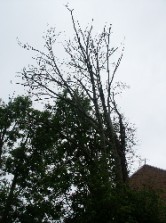BOUNDARY PROBLEMS
If trees overhang a boundary, they can cause problems. However, if you are on the receiving end of this you are usually entitled to remove the overhang, so long as it does not damage the rest of the tree or compromise its health and stability.
| Roots are harder to see but the law is the same. Oddly enough, if the cut material has any value (e.g. fruit or timber or firewood) you have to offer it to the owner so as to avoid being charged with theft. Obviously, this has the makings of a neighbour dispute, so an amicable agreement is by far the best way to approach this. Before you set to on an overhanging tree or hedge, it would be a very good idea to contact the owner and make sure they know you are going to do the work. It will almost always be easier if you can co-operate with them. |  |
If the works are anything more than minor works then you should consider employing a competent person to do the work for you. Don't risk killing the tree and facing a claim for compensation. Get the contractor to write down, preferably on headed paper, a clear description of exactly what he is going to do and what its effect will be. This is especially important if you think the neighbour might accuse you of deliberately trying to damage the tree/hedge or kill it. If you can show that you used a qualified professional this will be a good defence against such accusations.
Make sure you know exactly where your boundary is, and do not go over it at all or do anything to any tree or hedge beyond it unless your neighbour has said you may. If there is any dispute between you and your neighbour about the exact location of your boundary, you should definitely seek legal advice before you proceed. Otherwise, you risk prejudicing any future action against your neighbour to establish the boundary itself.
If the offending tree is interfering with the fabric of your buildings or other structures, contact your insurers and ask their advice before going any further. They might be able to do the negotiations for you which would be a very good thing from your point of view.
Be sure that the tree is not protected by a TPO or planning conditions, or is in a Conservation Area. This is your responsibility regardless of who owns it or even if you don't know who owns it. If any of these are true, you must apply for consent (or notify them of your intention 6 weeks beforehand if in a conservation area) from the Council before doing any work.
Roots
The effect of roots on buildings is an extremely complex one, potentially disastrous and well beyond this website’s capacity to explain. If you think your buildings are being affected by roots from your trees or a neighbours' then you should definitely involve your insurers at an early stage. However, just because a tree is close to a building, does not mean that removing it is a desirable thing. In some cases, removing a tree can cause more trouble than leaving it in place. It is essential to get advice before taking any such action.
It is also true that roots do grow around drains (moisture condenses on the outside of cold pipes). However it is not true that roots can break drains, although if a drain is at all leaky or cracked they could certainly make it worse. So if roots block your drains you can cure the problem by fixing the drain promptly - the tree need not necessarily be removed although plenty of people will tell you otherwise.
It is also true that roots do grow around drains (moisture condenses on the outside of cold pipes). However it is not true that roots can break drains, although if a drain is at all leaky or cracked they could certainly make it worse. So if roots block your drains you can cure the problem by fixing the drain promptly - the tree need not necessarily be removed although plenty of people will tell you otherwise.
Trees overhanging a highway
Landowners have a statutory duty not to let vegetation obstruct an adjoining highway (which includes all public rights of way). If this is you, be sure to keep your trees cut. Although the Council’s highways authority will sometimes do this for you, they are not obliged to do so and can insist that you do it yourself. If you don't, they can do it anyway and charge you for the service.
Page last updated on: 07/01/2013





